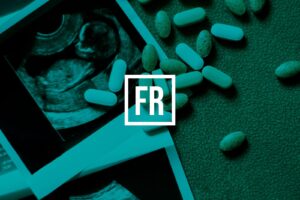A frequently overlooked cause of failed conception
There can be little doubt that embryo “incompetency” is by far the most important cause of IVF failure and that in >60% of such cases failure is attributable to numerical chromosomal irregularities (aneuploidy) of the embryo, which in turn is most commonly due to egg (rather than sperm) abnormalities. However, in about 20% of cases, the cause is due to “implantation dysfunction” rather than egg/embryo “incompetence”.
Common causes of Implantation Dysfunction
Anatomical implantation dysfunction
Regularity of the uterine cavity (endometrial polyps/scarring/submucous fibroids)
Endometrial Thickness and structure: With conventional IVF and with FET, endometrial lining at the time of the “trigger shot” or with the initiation of progesterone needs to preferably be at least 8 mm in sagittal thickness with a triple line (trilaminar) appearance. Anything less than an 8mm endometrial thickness is associated with a reduction in live birth rate per ET (embryo transfer).
One essential factor for successful implantation is the quality of the endometrium. Insufficient endometrial thickness can lower the chances of implantation. Therefore, it is crucial to ensure that the endometrium is in optimal condition before proceeding with embryo transfer.
Dr Esther Marbán, gynaecologist & fertility specialist at Clinica Tambre explains
The main causes of a “poor” uterine lining is damage to the basal endometrium because of:
- Inflammation of the endometrium (endometritis) most commonly resulting from infected products left over following abortion, miscarriage, or birth.
- Surgical trauma due to traumatic uterine scraping, (i.e., due to an overaggressive D & C)
- Insensitivity of the basal endometrium to estrogen due to:
- Prolonged, over-use/misuse of clomiphene citrate
- Over-exposure of the uterine lining to ovarian male hormones (mainly testosterone)
- Multiple uterine fibroids – especially when these are present under the endometrium (submucosal)
- Uterine adenomyosis (excessive, abnormal invasion of the uterine muscle by endometrial glands).
Vaginal Viagra administered vaginally, but not orally, in women who have these endometrial linings will help increasing the endometrial thickening by enhancing estrogen delivery to the basal (germinal) layer of the endometrium.
Immunologic implantation dysfunction (IID)
A partial list of immunologic factors that may be involved in these situations includes:
1. Activated uterine natural killer cells (NKa)
Functional NK cells reach a maximal concentration in the endometrium by about day 6-7 days after exposure to progesterone …. This timing corresponds with when the embryo implants into the uterine lining (endometrium).
It is important to bear in mind that measurement of the concentration of blood NK cells has little or no relevance when it comes to assessing NK cell activation (NKa). Rather, it is the NK cell activation that matters. In fact, there are certain conditions (such as with endometriosis) where the NK cell blood concentration is below normal, but NK cell activation is markedly increased.
There are several methods by which NK cell activation (cytotoxicity) can be assessed in the laboratory. Methods such as immunohistochemical assessment of uterine NK cells and/or through measurement of uterine or blood TH-1 cytokines. However, the K-562 target cell blood test still remains the gold standard. With this test, NK cells, isolated from the woman’s blood using Flow Cytometry are incubated in the presence of specific “target cells”. The percentage (%) of “target cells” killed is then quantified. More than 12% killing suggests a level of NK cell activation that usually requires treatment.
2. Antiphospholipid antibodies
Many women who experience “unexplained” IVF failure, women with RPL, those with a personal or family history of autoimmune diseases such as lupus erythematosus, rheumatoid arthritis, scleroderma, and dermatomyositis as well as women who have endometriosis (“silent” or overt) test positive for APAs.
More than 30 years ago, we were the first to propose that women who test positive for APA’s be treated with a mini-dose heparin to improve IVF implantation and thus birth rates. This approach was based upon research that suggested that heparin repels APAs from the surface of the trophoblast (the embryo’s “root system) thereby reducing its antimplantation effects. It is very possible that APAs alone do not cause IID but that their presence might help to identify a population at risk due to concomitant activation of uterine natural killer cells (Nka) which through excessive TH-1 cytokine production causes in IID.
3. Antithyroid antibodies (ATA)
Some years back, I reported on the fact that 47% of women who harbor thyroid autoantibodies, regardless of the absence or presence of clinical hypothyroidism, have activated uterine natural killer cells (NKa) cells and cytotoxic lymphocytes (CTL) and that such women often present with reproductive dysfunction. We demonstrated that appropriate immunotherapy with IVIG or intralipid (IL) and steroids, subsequently often results in a significant improvement in `reproductive performance in such cases. Treatment of those women who have thyroid antibodies + NKa/CTL using IL/steroids, improves subsequent reproductive performance while women with thyroid antibodies who do not harbor NKa/CTL do not require or benefit from such treatment.
There are two categories of immunologic implantation dysfunction (IID) linked to NK cell activation (NKa):
Autoimmune, IID
Here, Nka and CTL activation stems from an underlying autoimmune process. Such women often (but not always) have a personal or family history of autoimmune conditions such as Rheumatoid arthritis, Lupus Erythematosus, and thyroid autoimmune activity (e.g., Hashimoto’s disease) etc. Autoimmune as well as in about one third of cases of endometriosis, regardless of severity.
When it comes to treating NKa in IVF cases complicated by autoimmune implantation dysfunction, the combination of daily oral dexamethasone commencing with the onset of ovarian stimulation and continuing until the 10th week of pregnancy, combined with an initial infusion of IL (100ml, 20% Il dissolved in 500cc of saline solution, 10-14 days prior to PGT-normal embryo transfer and repeated once more (only), as soon as the blood pregnancy test is positive), the anticipated chance of a viable pregnancy occurring within 2 completed IVF attempts (including fresh + frozen ET’s) in women under 39Y (who have normal ovarian reserve) is approximately 65%.
Alloimmune, IID
Here, NK cell activation results from uterine exposure to an embryo derived through fertilization by a spermatozoon that shares certain genotypic (HLA/DQ alpha) similarities with that of the embryo recipient.
Partial DQ alpha/HLA match: Couples who upon genotyping are shown to share only one DQ alpha/HLA gene are labeled as having a “partial match”. The detection of a “partial match” in association with NKa puts the couple at a considerable disadvantage with regard to IVF outcome. It should be emphasized however, that in the absence of associated Nka, DQ alpha/HLA matching whether “partial” or “total (see below) will NOT cause an IID. Since we presently have no way of determining which embryo carries a matching paternal DQ alpha gene, it follows that each embryo transferred will have about half the chance of propagating a viable pregnancy. Treatment of a partial DQ alpha/HLA match (+Nka) involves the same IL, infusion as for autoimmune-Nka with one important caveat, namely that here we prescribe oral prednisone as adjunct therapy (rather than dexamethasone) and the ILinfusion is repeated every 2-4 weeks following the diagnosis of pregnancy and continued until the 24th week of gestation. Additionally, (as alluded to elsewhere) in such cases we transfer a single (1) embryo at a time. This is because, the likelihood is that one out of two embryos will “match” and we are fearful that if we transfer >1 embryo, and one transferred embryos “matches” it could cause further activation of uterine NK cells and so prejudice the implantation of all transferred embryos. Here it should be emphasized that if associated with Nka, a matching embryo will still be at risk of rejection even in the presence of Intralipid (or IVIg) therapy.
Total (complete) DQ alpha Match: Here the husband’s DQ alpha genotype matches both of that of his partner’s. While this occurs very infrequently, a total alloimmune (DQ alpha) match with accompanying Nka, means that the chance of a viable pregnancy resulting in a live birth at term, is unfortunately greatly diminished. Several instances in our experience have required the use of a gestational surrogate.
The following are examples of some proposed alternative approaches to managing implantation dysfunction. However, in my opinion they lack confirmation of efficacy:
- The use of the endometrial receptivity array (ERA) to determine the ideal window of implantation
- Granulocyte Stimulating Factor (Neupogen)
- Uterine platelet rich plasma (PRP) for uterine washes;
- Endometrial flushing with hCG solution
- Endometrial scratch
While clearly there are many other factors that can influence embryo implantation, the two categories (anatomical and Immunologic) addressed here are by far the most important significant, probably accounting for more than 80% of dysfunctional embryo implantation. This is especially relevant in cases of “unexplained” IVF failure, Recurrent Pregnancy Loss (RPL) and in cases where the woman has a personal or family history of autoimmune diseases. Addressing these issues will go a long way towards maximizing the chance of pregnancy, enhancing the quality of placentation, and promoting the noble objective of optimizing the quality of life after birth.






